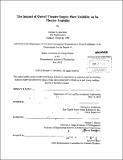| dc.contributor.advisor | Richard R. Hildebrant | en_US |
| dc.contributor.author | Giordano, Michael A. (Michael Anthony) | en_US |
| dc.contributor.other | Massachusetts Institute of Technology. Dept. of Civil and Environmental Engineering. | en_US |
| dc.date.accessioned | 2012-10-10T15:46:02Z | |
| dc.date.available | 2012-10-10T15:46:02Z | |
| dc.date.copyright | 2012 | en_US |
| dc.date.issued | 2012 | en_US |
| dc.identifier.uri | http://hdl.handle.net/1721.1/73795 | |
| dc.description | Thesis (S.M. in Transportation)--Massachusetts Institute of Technology, Dept. of Civil and Environmental Engineering, 2012. | en_US |
| dc.description | Cataloged from PDF version of thesis. | en_US |
| dc.description | Includes bibliographical references (p. 100-101). | en_US |
| dc.description.abstract | The United States Army's end-to-end logistical network during times of conflict is made up of two separate networks. One network, managed by the Department of Defense, controls the shipment of supplies from the manufacturing facility to the theater of conflict. The other network managed by the Army, receives these supplies and distributes them to the units within the theater of operation. The synchronization between these two networks impacts the ability of Army logistical planners to efficiently manage the in-theater supply chain. Past operations demonstrate that Army planners have minimal visibility into the supplies entering the theater of operation. This causes units to become dangerously low on supplies, compromising their ability to successfully complete missions. This thesis evaluates the impact this lack of visibility has on the performance of the in-theater supply chain. A logistical planner is developed, modeled after current operating procedures, to maximize a unit's satisfaction, by keeping their supply levels within an acceptable range. Using mixed linear programming the planner determines the amount of each supply and the numbers of vehicles required to transport the supplies. Results confirm that increasing the visibility of incoming supplies improves the performance of the planner. The amount of improvement is dependent on the selection of specific parameters. Additionally, the variation in the amount of supplies entering a theater has an effect on the planner's performance. We conclude that there is an operational benefit in having future knowledge of incoming supplies. | en_US |
| dc.description.statementofresponsibility | by Michael A. Giordano. | en_US |
| dc.format.extent | 101 p. | en_US |
| dc.language.iso | eng | en_US |
| dc.publisher | Massachusetts Institute of Technology | en_US |
| dc.rights | M.I.T. theses are protected by
copyright. They may be viewed from this source for any purpose, but
reproduction or distribution in any format is prohibited without written
permission. See provided URL for inquiries about permission. | en_US |
| dc.rights.uri | http://dspace.mit.edu/handle/1721.1/7582 | en_US |
| dc.subject | Civil and Environmental Engineering. | en_US |
| dc.title | The impact of out-of-theater supply flow visibility on in-theater logistics | en_US |
| dc.type | Thesis | en_US |
| dc.description.degree | S.M.in Transportation | en_US |
| dc.contributor.department | Massachusetts Institute of Technology. Department of Civil and Environmental Engineering | |
| dc.identifier.oclc | 810459892 | en_US |
